Nestled deep within the verdant canopies of tropical rainforests, a vision of ethereal beauty unfolds—the Pink-Headed Fruit Dove (Ptilinopus porphyreus).
With its delicate hues and graceful demeanor, this avian gem captivates the hearts of all who encounter it. Join us on a journey into the enchanting world of the Pink-Headed Fruit Dove as we uncover the mysteries and marvels of this rare and exquisite species.
Adorned with a palette of pastel pinks and lush greens, the Pink-Headed Fruit Dove emerges as a symbol of tranquility amidst the emerald embrace of its habitat.
Its soft cooing resonates through the forest, a gentle melody that harmonizes with the rustle of leaves and the murmur of streams.
Yet, beyond its aesthetic allure lies a fascinating tale of survival and adaptation in one of nature’s most biodiverse ecosystems. Together, let’s delve into the realm of the Pink-Headed Fruit Dove.
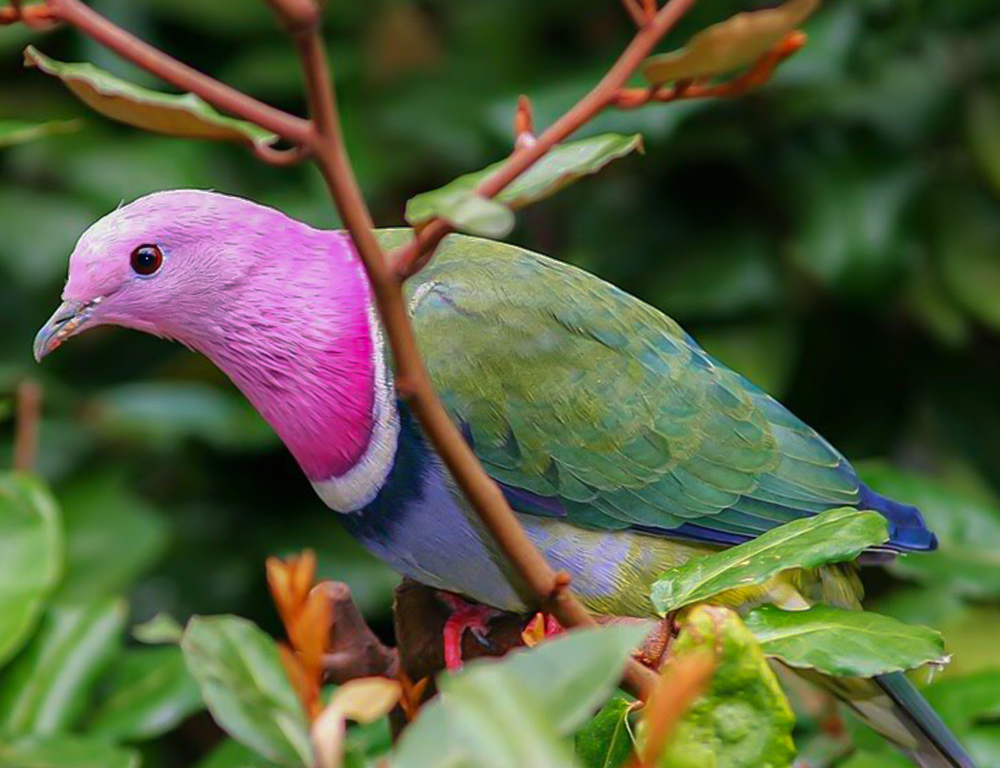
Key Physical Characteristics of the Pink-Headed Fruit Dove
The Pink-Headed Fruit Dove is a captivating avian species known for its stunning plumage and distinctive features. Here, we explore the key physical characteristics that make this bird a true marvel of nature.
Size and Shape
The Pink-Headed Fruit Dove is a medium-sized bird, typically measuring around 20 to 23 centimeters (8 to 9 inches) in length. It has a compact and rounded body with a relatively short tail and wings, giving it a streamlined appearance ideal for navigating dense forest canopies.
Plumage
One of the most striking features of the Pink-Headed Fruit Dove is its vibrant plumage, which varies between male and female individuals.
Adult males typically display a rich pink or mauve coloration on their head, neck, and upper breast, contrasting with a pale green or olive-green body.
In contrast, females have a more subdued plumage with less intense pink hues and more muted green tones. Both sexes exhibit a distinctive yellow patch on the wings, conspicuous during flight.
Head and Facial Features
As its name suggests, the Pink-Headed Fruit Dove is characterized by its distinctive pink or mauve-colored head, which contrasts sharply with the green tones of its body plumage.
Its head is relatively small and rounded, with a short, stout bill adapted for feeding on fruits and seeds. The bird’s eyes are typically dark and round, set against pale facial skin.
Bill and Feet
The Pink-Headed Fruit Dove possesses a short, stout bill with a slightly curved tip, well-suited for grasping and manipulating small fruits and seeds.
Its feet are small and delicate, with three forward-facing toes and one backward-facing toe, allowing for secure perching on branches and agile movement through the forest understory.
Wings and Tail
The wings of the Pink-Headed Fruit Dove are relatively short and rounded, providing excellent maneuverability for navigating through dense vegetation.
During flight, the wings reveal a striking combination of colors, with a prominent yellow patch on the primaries and coverts.
The tail is short and squared-off, adding to the bird’s agile and acrobatic flight capabilities.
Sexual Dimorphism
Sexual dimorphism in the Pink-Headed Fruit Dove is primarily evident in the intensity of the pink coloration on the head and neck. Males typically exhibit brighter and more vibrant pink hues than females, particularly during the breeding season.
Additionally, males may have more pronounced markings and a slightly larger body size than females, although these differences can be subtle.
A Deeper Look into the Life History of the Pink-Headed Fruit Dove
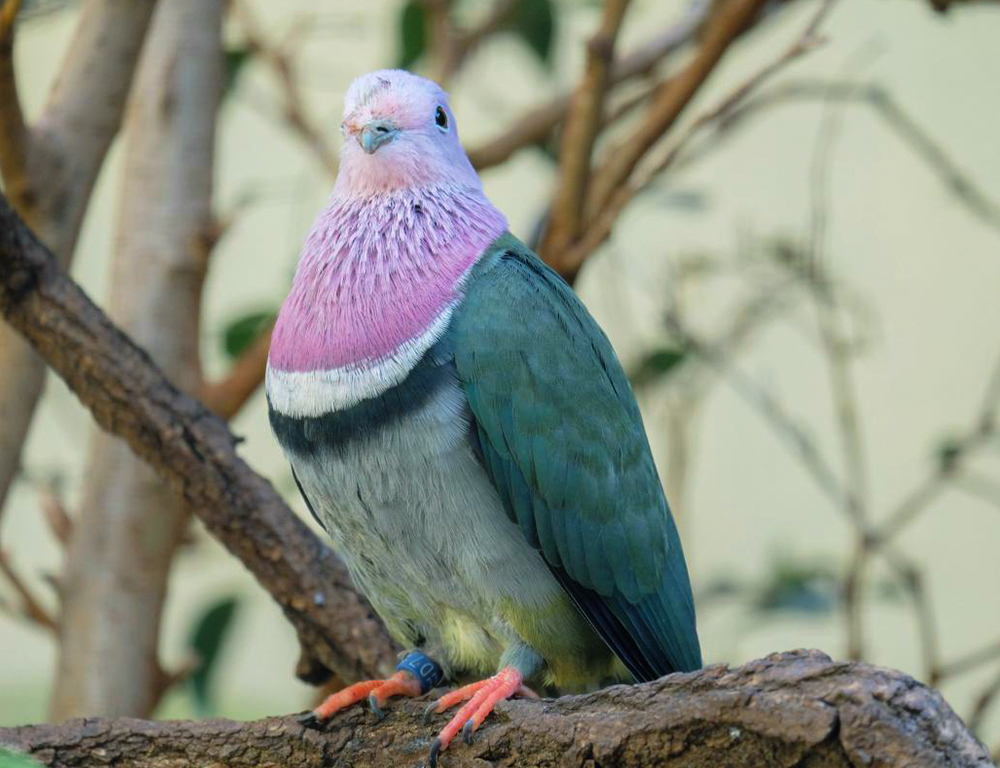
Let’s dive deeper into the taxonomy, nesting habits, breeding behaviors, and more as we unravel the secrets of this enchanting species:
Taxonomy
| Taxonomy Level | Classification |
| Kingdom | Animalia |
| Phylum | Chordata |
| Class | Aves |
| Order | Columbiformes |
| Family | Columbidae |
| Genus | Ptilinopus |
| Species | Ptilinopus porphyreus |
Food Habitat
The Pink-Headed Fruit Dove is primarily frugivorous, feeding on a diet consisting mainly of various fruits, berries, and seeds in its forest habitat.
It plays a crucial role in seed dispersal, helping maintain plant species’ diversity and regeneration within its ecosystem.
Nesting Habits
| Nest Type | Description |
| Cup Nest | Nests are commonly situated in the canopy of tropical rainforests, often near food and water sources. The dense vegetation offers concealment and protection from predators and the elements. |
| Location | The nest’s interior may be lined with softer materials such as moss, feathers, or finer plant fibers, providing insulation and comfort for the eggs and chicks during incubation and brooding. |
| Construction | Both male and female Pink-Headed Fruit Doves participate in nest building, with the female primarily responsible for incubating the eggs. The nest is typically constructed on a sturdy tree branch or fork. |
| Lining Material | Pink-Headed Fruit Doves typically lay a single egg per clutch, although occasionally, they may lay two eggs. The timing of egg-laying and clutch size may vary depending on food availability and environmental conditions. |
| Clutch Size | Chicks proliferate under the care of both parents, with fledging occurring around 14 to 21 days after hatching. After leaving the nest, juveniles may remain dependent on their parents for several weeks as they learn to forage and navigate their forest habitat. |
| Incubation Period | The incubation period for Pink-Headed Fruit Dove eggs is approximately 14 to 18 days, with both parents taking turns incubating the eggs. Upon hatching, the chicks are altricial and dependent on parental care for warmth and food. |
| Chick Development | Both male and female Pink-Headed Fruit Doves share parental duties, including nest building, incubation, and chick rearing. They provide warmth, protection, and regurgitated food for their offspring, ensuring their survival and growth until they can independently live. |
| Parental Care | Both male and female Pink-Headed Fruit Doves share parental duties, including nest building, incubation, and chick rearing. They provide warmth, protection, and regurgitated food for their offspring, ensuring their survival and growth until they are capable of independent living. |
Breeding
Pink-Headed Fruit Doves typically breed during the wet season when food resources are abundant. Courtship displays may involve elaborate vocalizations, wing-flapping, and ritualized feeding behaviors.
Once a pair has formed, they will work together to construct a nest and raise their offspring, demonstrating strong bonds and cooperative behavior throughout the breeding process.
Vocalizations
Pink-Headed Fruit Doves are known for their soft cooing calls, which they use for communication within their social groups and during courtship displays.
These melodious calls echo through the forest canopy, serving as a means of establishing territory, attracting mates, and maintaining contact with other individuals.
What Is the Range Map and Conservation Status of the Pink-Headed Fruit Dove?
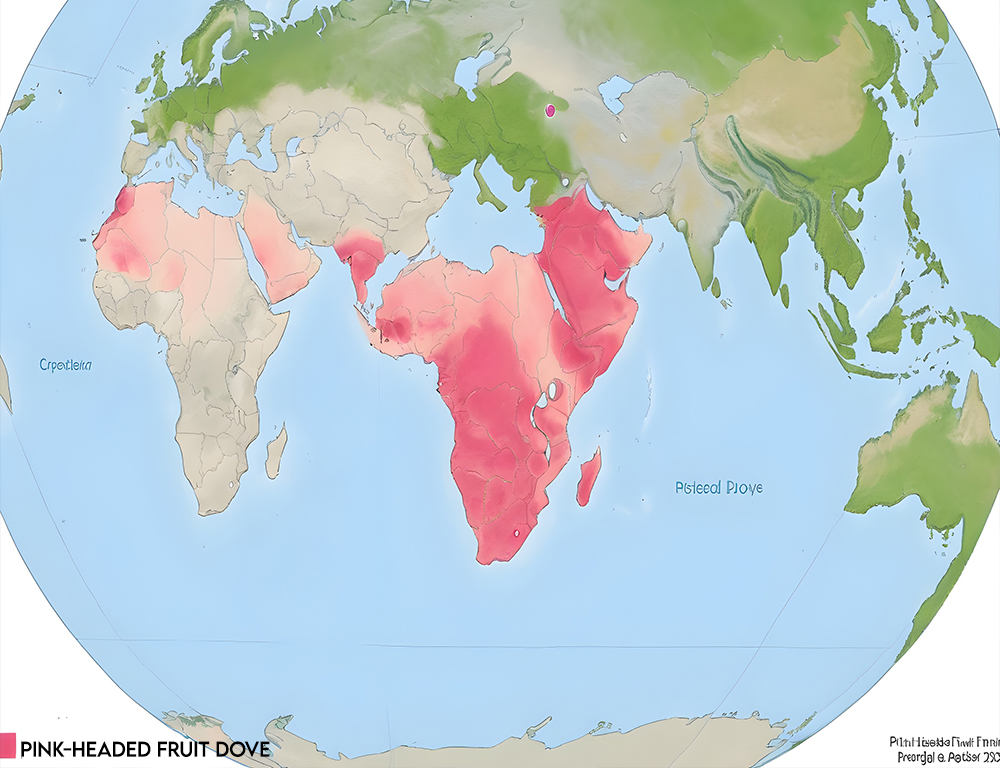
Embark on a journey to uncover the Pink-Headed Fruit Dove’s geographical range and conservation status.
Range Map
The Pink-Headed Fruit Dove is native to the tropical rainforests of Southeast Asia, including regions of Indonesia, Malaysia, and the Philippines.
Its range extends across various islands within this region, inhabiting dense forest canopies and foraging for fruits and seeds.
While its distribution is primarily concentrated in lowland and montane forests, it may also occur in disturbed habitats and secondary-growth forests.
Conservation Status
The Pink-Headed Fruit Dove is currently classified as Least Concern (LC) by the International Union for Conservation of Nature (IUCN) Red List.
While there are no significant threats to the overall population, localized declines may occur due to habitat loss and degradation caused by deforestation, logging, and agricultural expansion.
Conservation efforts focused on protecting remaining forest habitats, implementing sustainable land management practices, and raising awareness about the importance of biodiversity conservation is essential for ensuring the long-term survival of this species.
What Are the Common Diseases and Treatments of the Pink-Headed Fruit Dove?
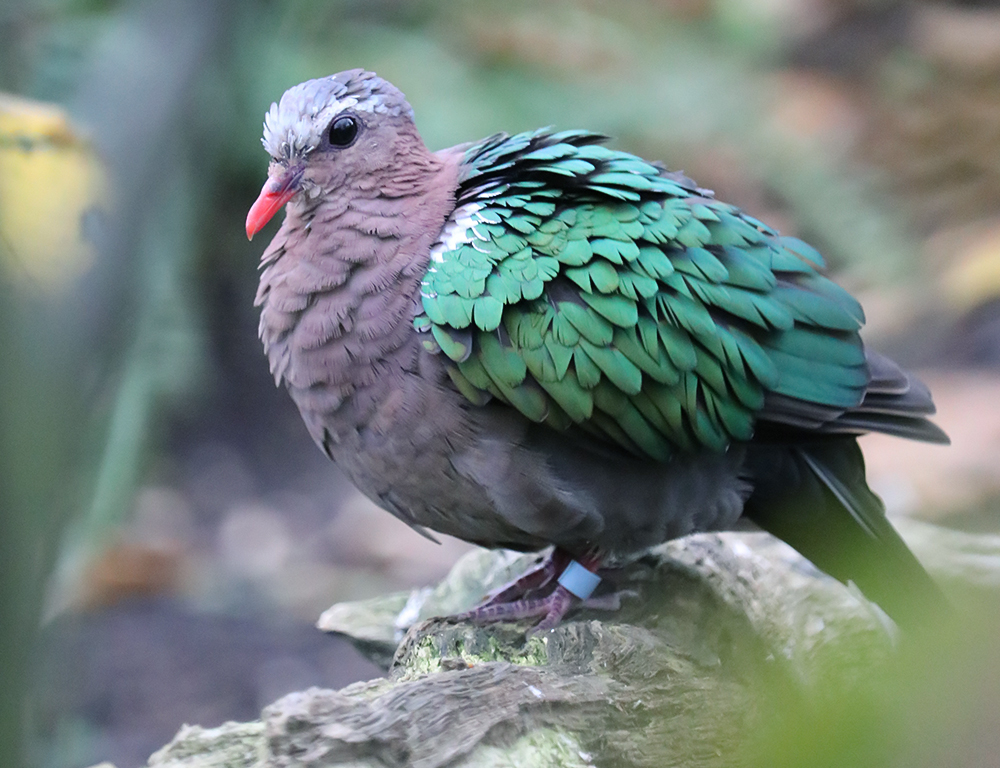
Like other avian species, Pink-Headed Fruit Doves are susceptible to various diseases and health issues. Some common diseases and their treatments include:
Respiratory Infections
Respiratory infections can occur due to bacterial, viral, or fungal pathogens. Treatment typically involves antibiotics, antiviral medications, or antifungal agents prescribed by a veterinarian.
Supportive care, such as maintaining optimal environmental conditions and providing nutritious food and clean water, can also aid recovery.
Parasitic Infestations
External parasites like mites and lice can infest the plumage of Pink-Headed Fruit Doves, leading to irritation and discomfort. Treatment may involve topical parasiticides or bathing solutions recommended by a veterinarian.
Internal parasites such as worms may require deworming medication administered orally or through the diet under veterinary supervision.
Nutritional Deficiencies
Inadequate diet or improper nutrition can result in nutritional deficiencies, affecting the overall health of Pink-Headed Fruit Doves. Treatment may involve dietary supplementation or modification to address specific nutrient deficiencies.
A balanced diet rich in fruits, vegetables, seeds, and commercial avian pellets is essential for optimal health.
Injuries
Pink-Headed Fruit Doves may suffer injuries from collisions with objects, predation attempts, or territorial disputes.
Treatment depends on the severity and nature of the injury but may include wound cleaning, pain management, and supportive care to promote healing. In some cases, surgical intervention may be necessary.
Environmental Stress
Environmental stressors such as habitat disturbance, temperature extremes, and overcrowding can weaken the immune system of Pink-Headed Fruit Doves, making them more susceptible to diseases.
Minimizing stressors and providing a clean, spacious, and enriching environment can help prevent disease outbreaks and promote overall well-being.
8 Fun Facts About the Pink-Headed Fruit Dove
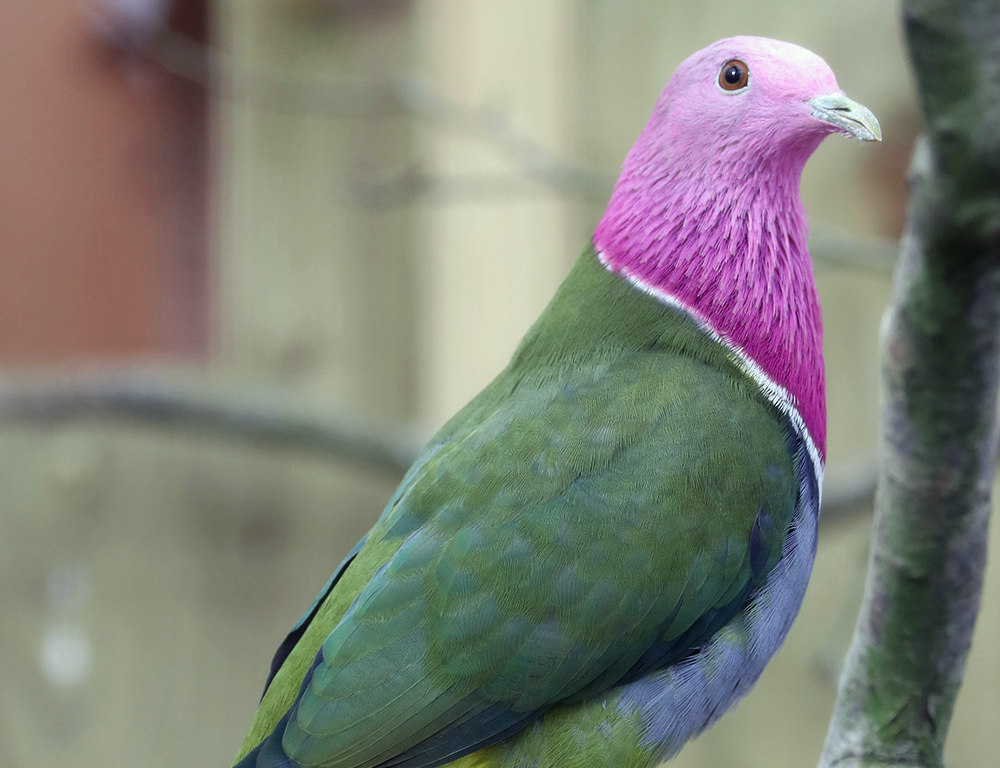
Prepare to be enchanted as we unveil eight fascinating facts about the Pink-Headed Fruit Dove.
Subtle Sexual Dimorphism
While both male and female Pink-Headed Fruit Doves exhibit pink hues on their heads, males typically have brighter and more vibrant pink coloration, making it easier to distinguish between the sexes.
Fruity Diet Preferences
As their name suggests, Pink-Headed Fruit Doves primarily feed on a diet of fruits and berries found within their forest habitat, playing a crucial role in seed dispersal and forest regeneration.
Shy and Elusive Nature
Pink-Headed Fruit Doves are known for their shy and elusive behavior, often remaining hidden within the dense foliage of trees and rarely venturing into open areas.
Muted Plumage of Juveniles
Juvenile Pink-Headed Fruit Doves have a more subdued plumage than adults, with less intense pink coloration on their heads and more muted green tones overall, providing camouflage in their forest environment.
Cryptic Nesting Behavior
Pink-headed fruit Doves exhibit cryptic nesting behavior, constructing cup-shaped nests high in the canopy of trees to protect their eggs and chicks from predators and the elements.
Seasonal Breeding Patterns
Breeding in Pink-Headed Fruit Doves typically occurs during the wet season when food resources are abundant, with courtship displays involving elaborate vocalizations and ritualized feeding behaviors.
Cooperative Parental Care
Both male and female Pink-Headed Fruit Doves share parental duties, including nest building, incubation, and chick rearing, demonstrating solid bonds and cooperative behavior throughout the breeding process.
Vocal Melodies
Pink-Headed Fruit Doves are known for their soft cooing calls, which echo through the forest canopy and serve as a means of communication within their social groups, establishing territory, and attracting mates.
FAQs
What is the habitat of the Pink-Headed Fruit Dove?
Pink-Headed Fruit Doves inhabit tropical rainforests, preferring dense canopy cover where they can forage for fruits and berries. They are commonly found in lowland and montane forests across Southeast Asia.
What does the Pink-Headed Fruit Dove eat?
As frugivores, Pink-Headed Fruit Doves primarily consume fruits and berries in their forest habitat. They play a vital role in seed dispersal, helping maintain plant species’ diversity in their ecosystem.
How do Pink-Headed Fruit Doves reproduce?
Pink-headed fruit Doves typically breed during the wet season, engaging in courtship displays that involve vocalizations and ritualized feeding behaviors. They construct cup-shaped nests high in the forest canopy, where both parents share incubation and chick-rearing duties.
Are Pink-Headed Fruit Doves Endangered?
Currently, Pink-Headed Fruit Doves are classified as Least Concern by the IUCN Red List, indicating that they are not facing immediate threats of extinction. However, localized declines may occur due to habitat loss and degradation in some regions.
How can Pink-Headed Fruit Doves be distinguished from other dove species?
Pink-Headed Fruit Doves can be identified by their distinctive pink or mauve-colored heads, contrasting with green plumage on their bodies.
Conclusion
As we bid farewell to the enchanting world of the Pink-Headed Fruit Dove, we are reminded of the delicate balance of nature and the wonders that await within the depths of our planet’s rainforests.
Through its pastel plumage and tranquil presence, this elusive bird offers a glimpse into the hidden treasures of biodiversity and the interconnectedness of all living beings.
In the face of increasing threats from habitat loss and human encroachment, the Pink-Headed Fruit Dove serves as a poignant reminder of the importance of conservation efforts to safeguard our planet’s precious ecosystems.
By protecting the habitats that sustain species like the Pink-Headed Fruit Dove, we preserve their beauty and diversity and ensure a future where nature’s splendor continues to inspire and amaze generations to come.
As stewards of the Earth, let us embrace the lessons learned from the Pink-Headed Fruit Dove.
